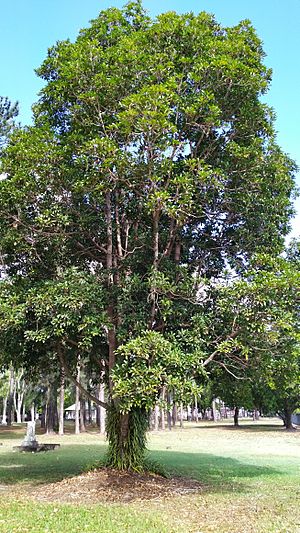Johnstone River almond facts for kids
Quick facts for kids Johnstone River almond |
|
|---|---|
 |
|
| Scientific classification | |
| Genus: |
Elaeocarpus
|
| Species: |
bancroftii
|
Elaeocarpus bancroftii, commonly known as Kuranda quandong, Johnstone River almond, ebony heart, grey nut, or nut tree is a species of flowering plant in the family Elaeocarpaceae and is endemic to Queensland. It is a tree with leathery leaves that turn red before falling, flowers with lobed petals and relatively large fruit.
Contents
Description
Elaeocarpus bancroftii is a tree growing up to 30 m (98 ft) with a bole diameter of 60 cm (24 in) and bushy, dark green foliage. The leaves are leathery, about 80–130 mm (3.1–5.1 in) long and 25–50 mm (0.98–1.97 in) wide and turn bright red before falling. The flowers have petals with three to five lobes or teeth on the tip, and between forty-five and fifty stamens. Flowering occurs from March to June, and is followed by large, dull grey/green, globular drupes about 30–40 mm (1.2–1.6 in) in diameter containing a single seed with a very hard, thick endocarp.
Taxonomy
Elaeocarpus bancroftii was first formally described in 1886 by botanists Ferdinand von Mueller and Frederick Manson Bailey in Proceedings of the Royal Society of Queensland, based on plant material collected on the Johnstone River by Thomas Lane Bancroft.
Distribution and habitat
Elaeocarpus bancroftii is endemic to north east Queensland, growing in well developed rainforest from near Cooktown southwards to about Tully and from near sea level to 1,200 m (3,900 ft).
Ecology
Fallen fruits of E. bancroftii are eaten by cassowaries and the seeds are eaten by native rats, (notably the giant white-tailed rat, Uromys caudimaculatus), after chewing its way through the hard shell.
Conservation status
This quandong is listed as of "least concern" under the Queensland Government Nature Conservation Act 1992.
Uses
Indigenous uses
Australian aborigines ate the seeds, although the very hard shell required them to use stones to crack them open. These special "nut stones" were sometimes left under the tree.
Use in food
The 1889 book 'The Useful Native Plants of Australia' records that "The cotyledons or 'kernels' have a good flavour, and are eaten by the settlers. Other species of Elaeocarpus have fruits which are more or less useful in this respect. Johnstone River, Queensland."
Use in horticulture
The plant is sold as an ornamental and shade tree.
Images for kids












